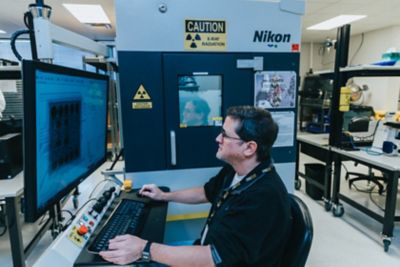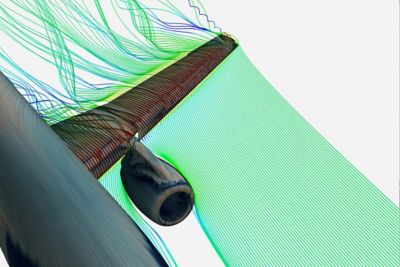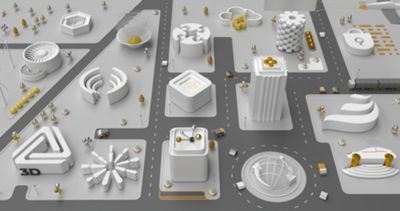-
United States -
United Kingdom -
India -
France -
Deutschland -
Italia -
日本 -
대한민국 -
中国 -
台灣
-
Ansys는 학생들에게 시뮬레이션 엔지니어링 소프트웨어를 무료로 제공함으로써 오늘날의 학생들의 성장을 지속적으로 지원하고 있습니다.
-
Ansys는 학생들에게 시뮬레이션 엔지니어링 소프트웨어를 무료로 제공함으로써 오늘날의 학생들의 성장을 지속적으로 지원하고 있습니다.
-
Ansys는 학생들에게 시뮬레이션 엔지니어링 소프트웨어를 무료로 제공함으로써 오늘날의 학생들의 성장을 지속적으로 지원하고 있습니다.
광기계 설계란?
광기계 설계는 광학 설계의 하위 분야로, 구조적, 동적 및 열적 부하가 광학 성능에 미치는 영향을 최소화하면서 광학 구성 요소를 고정하거나 이동하는 기계적 구조에 통합하는 데 중점을 둡니다. 제조 가능하고 비용 효율적이며 견고한 광학 장치를 생산하는 것을 목표로 광학 설계와 기계 설계가 교차하는 분야입니다.
결과물은 설계의 구성 요소 비용, 제조 비용 및 일정, 조립 비용 및 일정, 기계적 신뢰성, 유지 관리 노력, 크기, 무게, 패키징 및 운송, 정렬 용이성, 광학 성능을 비롯한 광범위한 요구 사항을 충족해야 합니다.
광기계 설계는 광학 테이블에서 광학 시스템을 설계하는 것과는 다르며, 광기계 설계의 목표는 그야말로 광학의 프로토타입을 제작하거나 광학 과학의 새로운 영역을 탐구하는 것입니다. 광기계학은 일반적으로 광학 엔지니어나 연구원이 아닌 사람들이 광학 실험실 외부에서 사용하는 제품의 기계적 부분에 초점을 맞춥니다. 스마트폰의 카메라부터 James Webb 우주 망원경의 거울과 렌즈에 이르기까지 전체 제품이 모든 설계 목표를 충족하거나 초과하도록 보장하기 위해서는 광범위한 광기계학이 필요합니다.
광기계 설계의 5단계
Ansys Zemax OpticStudio 광학 시스템 설계 및 분석 소프트웨어와 같은 툴을 사용하여 광학 장치의 광 경로를 정의하고 특성화하면 광학 형상을 시작점으로 사용하여 광기계 설계 프로세스를 시작할 수 있습니다.
각 광학 장치에는 서로 다른 요구 사항과 설계 단계가 있지만, 대부분의 단계는 다음 다섯 가지 범주 중 하나에 속합니다.
1. 재료 선택
첫 번째 단계는 시스템의 각 광학 및 기계 부품을 제조하는 데 사용되는 재료를 정의하는 것입니다. 렌즈는 유리 또는 폴리머로 만들 수 있으며, 거울과 기계 구성 요소에는 여러 가지 재료 옵션이 있습니다.
열팽창 계수(CTE)의 차이로 인해 정렬, 응력 및 기계적 피로 문제가 발생할 수 있으므로 열팽창 계수가 유사한 재료를 선택하는 것이 중요합니다. 알루미늄과 스테인리스강은 구조적 구성 요소에 널리 사용되는 재료입니다. 유리 또는 탄소 충전 폴리머는 더 가벼운 무게로도 유사한 속성을 제공할 수 있으며, 복합 재료는 매우 높은 강성과 낮은 CTE를 제공할 수 있습니다. 설계 엔지니어는 상용 구성 요소를 사용하는 경우에도 해당 하위 조립 부품에 사용된 재료를 알아야 합니다.
기본 재료를 정의했다면 엔지니어는 적용할 후처리를 지정해야 합니다. 재료 후처리는 코팅, 양극 산화, 표면 마감 또는 열처리일 수 있습니다. 각 단계는 처리된 부품의 기계 및 광학적 특성에 영향을 미칩니다.
설계에서 재료 선택 시 고려해야 할 또 다른 사항은 접착제와 고정장치에 사용하는 재료입니다. 고정장치와 부착하는 재료의 열적 불일치로 인해 상당한 부하가 발생할 수 있습니다. 잘못된 접착제는 가스를 방출하여 광학 표면을 코팅할 수 있으며, 고정에 필요한 접착 강도가 충분하지 않으면 렌즈가 고정되어 있던 부분의 정렬이 어긋날 수 있습니다.
2. 구조 설계
광학 설계가 제대로 작동하려면 광 경로의 구성 요소가 공방향 및 위치를 유지해야 합니다. 광기계 설계자는 각 광학 구성 요소를 고정하는 데 가장 적합한 기계 구성 요소를 결정하고 기계적 구조가 어떻게 연결되어 조립품을 형성하는지 결정해야 합니다. 이 단계에서 공차가 필수적인 역할을 합니다.
또한 광학 기능에 작동 중 제어된 움직임이 필요한 경우 작동 메커니즘을 선택하고 설계해야 합니다. 표준 작동 방법에는 어미 나사 및 볼 나사, 정밀 나사산 인터페이스, 보이스 코일, 솔레노이드가 포함됩니다. 정밀 기어, 캠 및 전기 모터도 작동 장치의 일부가 될 수 있습니다. 적응 광학에서는 거울을 기계적 작동기에 의해 변형하여 광학적 속성을 변경하고 흔히 광학적 수차를 보정합니다.
구조 설계를 구성하는 대부분의 물체는 광학 장치를 고정하거나 이동시키지만, 일부는 광학 장치를 오염, 열적 부하 및 원치 않는 외부 빛으로부터 보호합니다. 배럴, 배플 및 인클로저는 광학 경로를 보호하는 데 사용되는 대표적인 구성 요소 중 일부입니다.
무게와 크기도 이 설계 프로세스의 일부에서 필수적인 역할을 합니다. 구조 설계는 광학 구성 요소의 위치와 장치가 들어맞아야 하는 외피(envelope)부터 시작됩니다. 외피 설계에는 질량이 포함됩니다. 엔지니어는 힘, 가속도, 온도 변화의 형태로 외부 부하를 평가하여 각 구성 요소가 얼마나 움직이거나 왜곡될 수 있는지 살펴보고 구조가 영구적으로 변형되거나 파손되지 않는지 확인합니다. 또한 먼지, 화학물질, 습기, 빛과 같은 원치 않는 오염 물질을 차단하기 위해 설계를 수정합니다.
구조 설계의 또 다른 부분은 열 관리입니다. 레이저와 같은 광원은 열을 발생시키는 경우가 많으며 센서는 일반적으로 매우 특정한 작동 온도 범위를 갖습니다. 둘 모두 허용 온도 한도 내에서 유지되어야 하며 때로는 수동, 능동, 극저온 냉각이 필요합니다.
3. 렌즈-마운트 인터페이스 설계
설계 팀은 광학 장치를 고정하거나 배치하는 방법을 결정한 후에 각 렌즈를 구조에 연결하는 방법을 정의해야 합니다. 광학 렌즈 마운트 설계는 입증된 방법으로 해결된 고유한 기계적 문제입니다. 리테이닝 링, 스냅 링, 스페이서 링, 링 플랜지, 엣지 마운트와 같은 고정 장치에는 각각 장단점이 있습니다. 엔지니어는 각 접근 방식의 부하, 비용, 광학 공차를 이해하여 올바른 접근 방식을 선택해야 합니다.
렌즈-마운트 인터페이스 설계는 렌즈 설계자와 기계 엔지니어 간에 상호작용을 하는 과정인 경우가 많습니다. 많은 장착 방식이 렌즈의 곡률과 광택이 나는 정밀 광학 표면에 의존하여 렌즈의 위치를 축 방향으로 고정하고 광학 축에서 회전하지 않도록 하기 때문입니다.
각 표면의 높은 정밀도를 통해 정확한 위치 지정이 가능합니다. 그라운드 림 또는 베벨의 허용오차가 낮으면 느슨해져서 렌즈를 제자리에 고정하는 데 적합하지 않게 됩니다. 일부 설계에서는 탄성중합체 또는 접착제가 렌즈와 지지 하드웨어 간의 인터페이스 역할을 적절히 수행합니다.
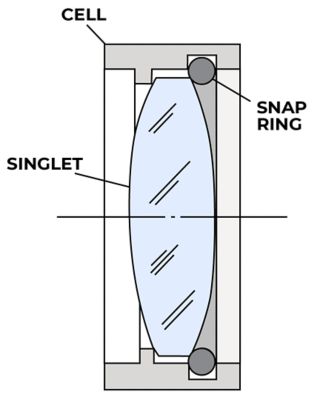
스냅 링 기법
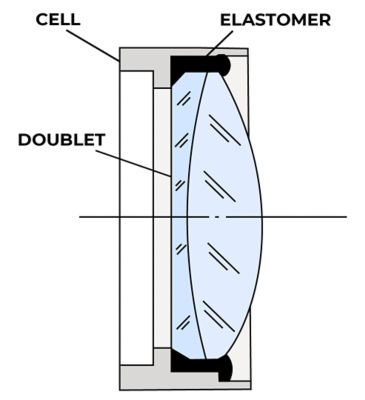
탄성중합체로 렌즈 고정
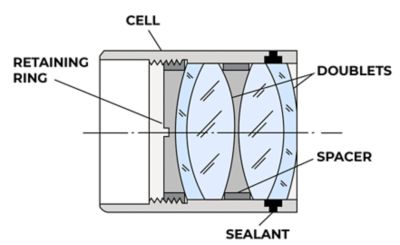
고정 초점 접안렌즈의 예
4. 기타 광학 구성 요소 인터페이스 설계
효과적인 설계에는 렌즈 외에도 구성 요소에 대한 광기계 인터페이스 정의가 포함됩니다. 광학 소스 및 감지기는 광 경로의 중요한 부분이며 다른 구성 요소와의 상대적인 위치가 중요합니다. 이들은 인쇄 회로 기판(PCB)에 장착되거나 자체 인클로저에 있는 경우가 많으므로 엔지니어는 장착 요구 사항을 이해하고 그에 따라 설계를 조정해야 합니다.
렌즈가 얇은 원통형인 경우 거울과 프리즘이 다양한 형태로 제공될 수 있으며, 이에 따라 엔지니어가 미러와 프리즘을 제자리에 고정하는 데 사용할 수 있는 옵션이 달라집니다. 미러는 왜곡에 특히 민감하므로 거울 장착 방식을 사용하여 거울이 휘어지는 것을 방지하고, 프리즘은 흔히 부피가 커질 수 있으며 광학 표면과 광축의 각도에 매우 민감합니다. 이러한 구성 요소 유형에 대한 일반적인 장착 방식으로는 클램프와 나사가 있으며, 접착제나 탄성중합체도 마찬가지입니다.
5. 비용, 제조 가능성, 조립 및 광학 정렬을 위한 설계
설계 작업의 마지막 범주에서는 다양한 설계 솔루션의 비용, 설계 솔루션이 광학 시스템의 제조 가능성에 미치는 영향, 조립 프로세스, 광학 구성 요소를 정렬하는 방법 등을 살펴봅니다. 이러한 모든 요인은 광학 시스템을 사용하는 제품의 전반적인 상업적 적용 가능성에 영향을 미칩니다.
팀은 제조 및 품질 엔지니어와 협력하여 조립품의 각 부품 비용을 절감할 뿐만 아니라 자동화되고 반복 가능한 방식으로 광학 구성 요소의 세척, 조립, 정렬, 위치 고정을 위한 예비 프로세스를 만들어야 합니다. 또한 설계를 PanDao에 내보내면 설계 단계에서 최적의 제작 체인 및 공급업체를 파악하여 비용 효율적이고 제조 가능한 솔루션을 보장할 수 있습니다.
광학 설계 프로세스에서 광기계학의 역할
대규모 프로젝트의 경우 기계, 광학 및 광기계 엔지니어 팀이 함께 협력하여 광기계학을 설계 프로세스에 통합합니다. 소규모 팀에서는 엔지니어가 여러 분야에 걸친 종합적 접근 방식을 취하고 광학 및 기계적 거동을 이해해야 합니다.
광기계학을 비롯한 광학 시스템의 일반적인 설계 흐름은 다음 단계로 나눌 수 있습니다.
- 광학 디자인
첫 번째 단계는 렌즈, 미러, 프리즘, 소스 및 감지기와 같은 시스템의 광학 구성 요소를 최적화하는 것입니다. 이 단계에서는 엔지니어가 각 광학 구성 요소의 속성, 모양, 위치, 상대적 위치를 정의합니다. 그런 다음, 광학 성능을 계산하고 빛이 광학 요소를 통과할 때 어떻게 변화하는지 예측하며 광학 성능이 설계 요구 사항을 충족할 때까지 형상과 위치를 변경합니다.
- 광기계 시스템 설계
전반적인 광기계 설계는 이러한 구성 요소를 고정하고 운영 중에 구성요소를 작동시켜야 하는 경우 기계적 동작을 제어하거나 외부 환경과 미광으로부터 구성 요소를 보호할 구조를 설계하는 데 중점을 둡니다. 또한 광기계 설계 팀은 비용을 계산하여 최소화하고 제조 가능성을 극대화하며 조립 및 정렬 요구 사항을 고려하기 위해 노력합니다.
- 광기계 부하 및 응답
다음으로, 엔지니어는 조립 및 작동 중에 중력, 온도 변화, 진동, 가속도, 힘과 같은 환경적 부하를 결정하고 적용합니다. 그런 다음, 기계적 구조가 편향되는 방식과 광학 구성 요소가 공칭 위치에서 왜곡되거나 이동되는 방식을 계산합니다.
- 광학 설계에 미치는 영향 평가
그런 다음, 왜곡되거나 변위된 광학 구성 요소를 사용해 광학 성능을 다시 평가하여 성능이 여전히 허용 가능한 범위 내에 있는지 확인합니다.
- 광학 설계와 광기계 설계 간 반복
결과적인 광학 성능이 허용 범위를 벗어나면 엔지니어는 비용과 광학 성능이 허용 가능한 수준이 될 때까지 광학 설계와 광기계 설계를 반복합니다. 정확하고 시기적절한 시뮬레이션, 의미 있는 테스트 데이터 및 다양한 분야 간의 명확한 의사소통은 반복 작업의 효과와 효율성을 촉진합니다.
광기계학의 과제 해결
각 설계 옵션의 경제적 영향과 일정에 미치는 영향을 최소화하면서 광학 시스템 성능을 허용 가능한 값 이내로 유지해야 합니다. 이 목표를 달성하는 것이 광기계학의 근본적인 과제입니다.
브레드보드를 수동으로 생성하고 수정할 수 있는 실험실 상황에서는 광학 설계 고려 사항이 지배적입니다. 그러나 이를 제품에 적용하면서 엔지니어는 설계를 최적의 솔루션으로 이끌 때 상충되는 요구 사항을 고려해야 합니다. 성공적인 팀은 시뮬레이션과 결합된 견고한 설계 프로세스를 사용하여 이러한 과제를 극복합니다.
협력적이고 여러 분야에 걸쳐 종합적이며 반복적인 설계 프로세스
업계는 더 반복적이고 여러 분야에 걸쳐 다분야 설계 프로세스의 필요성을 해결하기 위해 광기계학 하위 분야를 개발했습니다. 이를 도입하기 전에는 광학 엔지니어가 광학 설계를 개발하여 기계 엔지니어링 팀에 보내 광학 장치를 고정, 이동 및 보호하는 방법을 알아냈습니다. 이러한 단절된 접근 방식은 광학 사양을 충족하지 못하는 설계로 이어지거나 설계 프로세스 후반에 비용이 많이 드는 수정을 초래하는 경우가 많습니다.
이 문제를 해결하기 위해 기업은 광학 시스템의 고유한 기계적 측면과 광학의 기본 사항을 이해하는 엔지니어로 구성된 다분야 팀을 구성하여 설계 결정을 내릴 때 두 영역을 모두 고려합니다. 명확하고 빈번하며 간결한 의사소통은 다분야 팀의 성공에 핵심적입니다.
또한 설계 프로세스는 반복적이어야 하며, 두 영역 모두에서 설계 변경 사항을 평가할 수 있어야 합니다. 형상 및 공차 정보를 분야 간에 자유롭게 이동할 수 있는 툴이 준비되어 있어야 합니다. 광학 시스템 설계는 일반적으로 표준 개념, 예비 및 최종 설계 단계를 따르며, 각 단계마다 반복이 이루어집니다. 효율적인 팀은 시뮬레이션, 프로토타입 제작, 테스트, 설계 검토 및 적절한 엔지니어링 문서화를 활용하여 설계 프로세스 초기에 문제를 찾아 해결합니다.
시뮬레이션 기반 광기계 설계
광학 시뮬레이션과 기계적 시뮬레이션은 모두 광기계학의 과제를 해결하고 극복하는 데 중요한 역할을 합니다. 설계의 가상 표현을 만들면 엔지니어가 광학 및 기계적 관점에서 설계의 성능을 빠르게 이해할 수 있으며, 두 가지가 어떻게 상호작용을 하는지도 이해할 수 있습니다.
광기계 설계를 위한 일반적인 시뮬레이션 워크플로는 광학 시뮬레이션에서 도출한 형상을 가져와서 장착 및 인클로저 설계가 지정되는 기계 설계 툴로 전달합니다.
엔지니어는 Ansys Mechanical 구조 유한 요소 분석 소프트웨어와 같이 유한 요소 분석(FEA) 방법을 활용하는 구조, 운동학, 전산 유체 역학(CFD) 및 열 시뮬레이션 패키지를 사용하여 기계 설계의 다양한 측면을 시뮬레이션합니다. 그런 다음, 힘, 가속도, 충격, 진동, 온도 변화와 같은 환경적 부하를 적용하고 조립품이 어떻게 반응하는지 계산합니다.
시뮬레이션을 통해 시스템이 부하 상황에서 어떻게 동작하는지에 대한 추정치를 얻은 후 엔지니어는 결과적인 물리적 왜곡과 계산된 공차를 광학 시뮬레이션 툴로 다시 전달하며 광학 엔지니어는 이를 실행하고 검사하여 광학 성능이 허용 범위 내에 있는지 확인합니다.
더 효율적인 시뮬레이션 워크플로는 구성 요소 수준 설계에 Zemax OpticStudio와 같은 툴을 사용하는데, 이 툴은 광학 설계 소프트웨어 자체 내에서 점점 더 늘어나는 광기계 설계 및 시뮬레이션 기능을 포함하는 워크플로를 통해 Mechanical CAD와 직접 통합됩니다. Zemax OpticStudio Enterprise는 통합된 다중 물리 부하, 피팅 및 시각화 툴을 통해 이 워크플로를 한 단계 더 발전시켰습니다.
또한 엔지니어는 Ansys Speos CAD 통합 광학 및 조명 시뮬레이션 소프트웨어와 같은 시스템 수준의 광학 설계 및 검증 툴을 활용하여 다른 광기계 고려 사항을 평가할 수도 있습니다. Speos 소프트웨어를 사용하면 기계적 구성 요소에서 반사되는 미광, 광기계적 구성 요소에 의한 빛 차단 또는 비네팅(빔 경로 주변의 채도 또는 밝기가 어두워지는 현상)을 평가할 수 있습니다. 시스템 수준 검증은 감지기의 초점 및 스팟 크기의 품질과 모양도 살펴볼 수 있습니다.
광기계학의 미래
광기계학은 다양한 산업 분야에서 증가하는 광학 시스템 사용에 대처하기 위해 최근 몇 년 동안 빠르게 발전해 왔습니다. 이러한 산업은 다음을 위해 여러 카메라와 기타 센서를 사용합니다.
- 소비재
- 의료 기기
- 사진 촬영
- 계측학
- 광통신
- 제조 자동화
- 사물 인터넷(IoT)
- 지구 관측
- 항공우주 및 방위 분야
- 자동차 센서
- 자율주행 시스템 라이다 및 광학 카메라
- 과학 기구
- 천문학
제조 방법의 새로운 발전, 재료 과학의 개선, 소형화 그리고 광 정보의 처리 및 저장을 취급할 수 있는 대규모의 컴퓨팅 리소스는 이러한 진화하는 다양한 응용 분야를 촉진합니다.
이러한 모든 변화로 인해 광기계학의 개선 필요성이 커지고 있습니다.
다음은 엔지니어가 알고 대비해야 할 몇 가지 추세입니다.
지속적인 소형화
재료 및 제조 공정의 개선으로 광학 조립 부품과 이를 지원하는 광기계의 크기가 점점 더 작아지고 있습니다. 부품이 작아짐에 따라 구조적 구성 요소의 복잡성과 정밀도도 개선되어야 합니다.
또한 더 작은 설계는 온도 변화에 더 민감합니다. 소형화로 인해 물리적 테스트도 더 어려워졌으며, 이에 따라 광기계 설계의 프로토타입을 가상으로 제작하기 위한 시뮬레이션의 필요성이 커지고 있습니다.
적응 광학의 발전
렌즈와 거울의 모양을 적극적으로 변경하고 그에 따라 광학적 속성도 변경하는 것은 기계적 및 열적 부하로 인해 발생하는 왜곡을 보상하는 유망한 방법입니다. 이러한 실시간 조정에는 빠르고 정확한 전기기계적 작동과 결합되는 뛰어난 제어 소프트웨어가 필요합니다.
효과적이고 경제적인 적응 광학을 올바르게 설계하려면 강력한 광기계 워크플로가 포함되어 있으며 입증된 광학 설계 프로세스가 필요합니다.
적층 제조
3D 프린팅이라고도 하는 적층 제조(AM)를 사용하면 광기계 엔지니어가 복잡한 형상을 만들 수 있는 새로운 설계 자유를 누릴 수 있으며, 이를 통해 기계적 견고성과 열 관리를 크게 개선할 수 있습니다.
AM을 사용하면 복잡한 조립품을 단일 부품으로 만들거나 구조에 냉각 기능을 통합할 수 있습니다. 최신 AM 시스템은 고도로 정확한 금속, 폴리머 및 탄소 충전 폴리머 부품을 만들 수 있습니다.
더욱 까다로운 운영 환경
또한 광학 시스템 응용 분야의 성장은 더 혹독한 환경에서 광학 기기를 작동한다는 것을 의미합니다. 장치가 더 이상 제어된 환경 내에 있지 않기 때문에 온도 변화와 부하가 증가하고 있습니다
이에 대한 좋은 예는 자율주행 차량의 광학 응용 분야입니다. 자동차 설계자들은 심한 진동과 극한 기온을 감지하는 카메라 및 라이다 센서를 더 많이 추가하고 있습니다.
관련 리소스
시작하기
엔지니어링 과제에 직면하고 있다면우리 팀이 도와드리겠습니다. 풍부한 경험과 혁신에 대한 헌신을 가지고 있는 우리에게 연락해 주십시오. 협력을 통해 엔지니어링 문제를 성장과 성공의 기회로 바꾸십시오. 지금 문의하기






